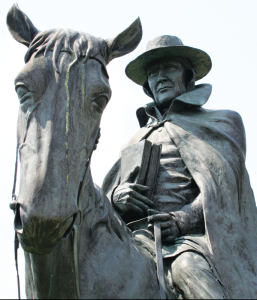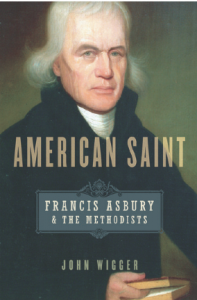
On September 4, 1771, Francis Asbury left England in order to preach the gospel in America. During his lengthy journey, Asbury asked himself, “Whither am I going? To the New World. What to do? … I am going to live to God, and to bring others so to do.” We celebrate this 250th anniversary of his crossing the Atlantic to share the gospel of Christ. Francis Asbury statue at Asbury Theological Seminary in Wilmore, Kentucky. Good News file photo.
By John Wigger –
Francis Asbury lived one of the most remarkable lives in American history, a life that many have admired but few have envied. The son of an English gardener, he became one of America’s leading religious voices and the person most responsible for shaping American Methodism.
During his 45-year career in America (he died in 1816), he never married or owned much more than he could carry on horseback. He led a wanderer’s life of voluntary poverty and intense introspection.
The church and the nation ultimately disappointed him, but his faith never did. Asbury embodies Methodism’s greatest successes and its most wrenching failures.
Asbury traveled at least 130,000 miles by horse and crossed the Allegheny Mountains some sixty times. For many years he visited nearly every state once a year, and traveled more extensively across the American landscape than probably any other American of his day. He preached more than ten thousand sermons and probably ordained from two thousand to three thousand preachers. He was more widely recognized face to face than any person of his generation, including such national figures as Thomas Jefferson and George Washington. Landlords and tavern keepers knew him on sight in every region, and parents named more than a thousand children after him. People called out his name as he passed by on the road.
Like any good eighteenth- or early nineteenth-century evangelical, Asbury was never satisfied with his own piety or labors. Yet people saw in him an example of single-minded dedication to the gospel that they themselves had never managed to attain, but to which, on their better days, they aspired. In their eyes he was indeed a saint. Though he spent his life traveling, he insisted on riding inexpensive horses and using cheap saddles and riding gear. He ate sparingly and usually got up at 4 or 5 a.m. to pray for an hour in the stillness before dawn. No one believed that Asbury was perfect, and even his most ardent supporters admitted that he made mistakes in running the church. Yet his piety and underlying motivations seemed genuine to almost everyone.
His legacy is not in books and sermons, but in the thousands of preachers whose careers he shaped one conversation at a time, and in the tens of thousands of ordinary believers who saw him up close and took him (in however limited a way) as their guide. Asbury communicated his vision for Methodism in four enduring ways.
1. Asbury had legendary piety and perseverance, rooted in a classically evangelical conversion experience. Piety isn’t a word we use much anymore. It simply refers to devotion to God and serving others, to a desire to “love the Lord thy God with all thy heart, and with all thy soul, and with all thy mind,” and “thy neighbour as thyself.”
Where most Methodists, even most preachers, settled for a serviceable faith, Asbury strove for a life of extraordinary devotion. During his forty-five years in America he essentially lived as a houseguest in thousands of other people’s homes across the land. He lived one of the most transparent lives imaginable, with no private life beyond the confines of his mind. Asbury’s piety brought him respect, even renown, based on sacrifice rather than accumulation of buildings, money, or other trappings of power.
2. Asbury communicated his vision through his ability to connect with ordinary people. As he crisscrossed the nation from year to year, he conversed with countless thousands, demonstrating a gift for building relationships face to face or in small groups. It is remarkable how many of those he met became permanent friends, even after a single conversation. They loved to have him in their homes. Asbury often chided himself for talking too much and too freely, especially late at night. He considered this love of close, often lighthearted, conversation a drain on his piety. In reality it was one of his greatest strengths, allowing him to build deep and lasting relationships and to feel closely the pulse of the church and the nation.
Henry Boehm, who traveled some 25,000 miles with Asbury from 1808 to 1813, recalled that “in private circles he would unbend, and relate amusing incidents and laugh most heartily.” He could also be funny, which enhanced his appeal.
3. Asbury understood and used popular culture. Asbury was remarkably well-informed (the product of his travels and love of conversation) and flexible in keeping up with these changes, but everyone has their limits. Though the American Revolution led to a good deal of persecution of American Methodists, Asbury fretted that its end would produce too much prosperity and thereby dampen Methodist zeal. As long as they were poor, most Methodists agreed with Asbury that wealth was a snare. But as Methodists became generally more prosperous, they became less concerned about the dangers of wealth, much to Asbury’s dismay.
4. Asbury communicated his message through his organization of the Methodist church. He was a brilliant administrator and a keen judge of human motivations. As Asbury crisscrossed the nation year in and year out, he attended to countless administrative details. Yet he never lost sight of the people involved. “I have always taken a pleasure as far as it was in my power, to bring men of merit & standing forward,” he wrote to the preacher Daniel Hitt in 1801.
The system Asbury crafted made it possible to keep tabs on thousands of preachers and lay workers. No merchant of the early nineteenth century could match Asbury’s nationwide network of class leaders, circuit stewards, book stewards, exhorters, local preachers, circuit riders, and presiding elders, or the movement’s system of class meetings, circuit preaching, quarterly meetings, annual conferences, and quadrennial general conferences, all churning out detailed statistical reports to be consolidated and published on a regular basis.
Under Asbury, the typical American itinerant rode a predominantly rural circuit 200 to 500 miles in circumference, typically with twenty-five to thirty preaching appointments per round. He completed the circuit every two to six weeks, with the standard being a four weeks’ circuit of 400 miles. This meant that circuit riders had to travel and preach nearly every day, with only a few days for rest each month.
 There was another component of Asbury’s system that went to the heart of what it meant to be a Methodist, to practice a method: the necessity of a culture of discipline. As individuals and communities, believers had to take it upon themselves to regulate their spiritual lives, to maintain their own spiritual focus. He insisted on upholding the requirement that all members attend class meetings and that love feasts be limited to active members, creating an atmosphere of mutual trust and support. Though there were plenty of disagreements along the way, Methodists succeeded where other religious groups failed largely because they were more disciplined.
There was another component of Asbury’s system that went to the heart of what it meant to be a Methodist, to practice a method: the necessity of a culture of discipline. As individuals and communities, believers had to take it upon themselves to regulate their spiritual lives, to maintain their own spiritual focus. He insisted on upholding the requirement that all members attend class meetings and that love feasts be limited to active members, creating an atmosphere of mutual trust and support. Though there were plenty of disagreements along the way, Methodists succeeded where other religious groups failed largely because they were more disciplined.
The Methodist church grew at an unprecedented rate, rising from a few hundred members in 1771, the year he came to America, to more than two hundred thousand in 1816, the year of his death. Methodism was the largest and most dynamic popular religious movement in America between the Revolution and the Civil War. In 1775, fewer than one out of every eight hundred Americans was a Methodist; by 1812, Methodists numbered one out of every thirty-six Americans.
He believed that true religion embraced the suffering of the poor and did all that was possible to alleviate it. This is why he allowed himself few comforts. He once told Boehm “that the equipment of a Methodist minister consisted of a horse, saddle and bridle, one suit of clothes, a watch, a pocket Bible, and a hymn book. Anything else would be an encumbrance.” Indeed, Asbury rarely owned much more than this. At the same time, he gave away nearly all the money that came his way.
“His charity knew no bounds but the limits of its resources; nor did I ever know him let an object of charity pass without contributing something for their relief,” John Wesley Bond wrote. He recalled that Asbury often gave money to strangers he met on the road whose circumstances seemed dire, especially widows. He had his share of failings, but the love of money wasn’t one of them.
Much of what makes human life so interesting – family, romance, creating an intellectual legacy – were largely absent from Asbury’s life after his arrival in America as a missionary. But Asbury’s life wasn’t flat, revolving as it did around the relationships he formed with other Methodists. Asbury lived his life in public, and the community of Methodist believers spread across the country became his vast extended family. He must be understood in this context or not at all. Like a rock thrown into a pond, his life sent ripples through the Methodist movement to its most distant reaches.
Asbury wasn’t an intellectual, charismatic performer, or autocrat, but his understanding of what it meant to be pious, connected, culturally aware, and effectively organized redefined religious leadership in America.
John Wigger is Professor of History at the University of Missouri. He is the author of PTL: The Rise and Fall of Jim and Tammy Faye Bakker’s Evangelical Empire, Taking Heaven by Storm: Methodism and the Rise of Popular Christianity in America and co-editor, with Nathan Hatch, of Methodism and the Shaping of American Culture. Reprinted with permission from American Saint: Francis Asbury & The Methodists by John Wigger, published by Oxford University Press, Inc. © 2009 Oxford University Press.






0 Comments